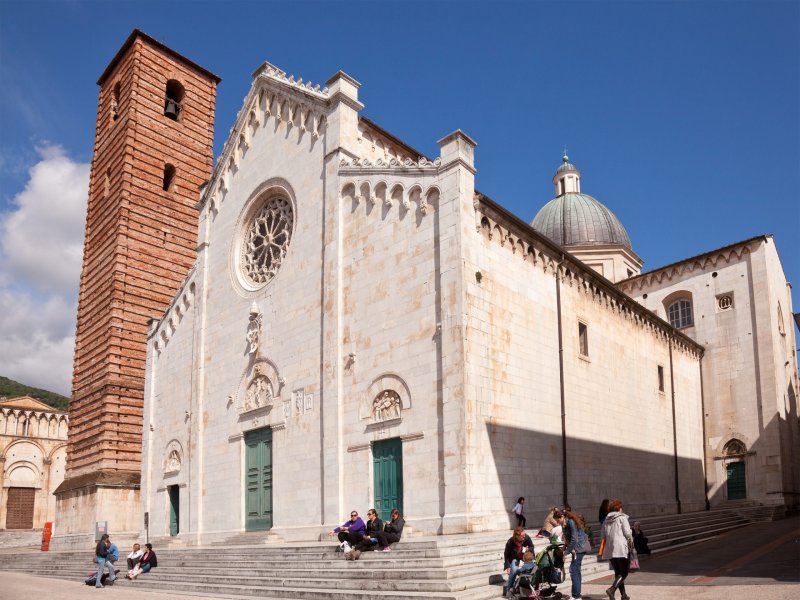
Duomo di Pietrasanta
L'esterno è rivestito di marmi bianchi che abbondano nella zona, con una facciata a salienti, dalla quale si intuisce il profilo interno con le tre navate.
L'esterno è rivestito di marmi bianchi che abbondano nella zona, con una facciata a salienti, dalla quale si intuisce il profilo interno con le tre navate. Sui ognuno dei tre portali sono lunette scolpite che riportano altrettante scene della Passione e Resurrezione di Cristo, attribuite genericamente alla scuola pisana. Nel transetto destro si apre un'altra porta su Via Garibaldi, anche questa sormontata da una lunetta scolpita che raffigura San Giovanni Battista, opera trecentesca di Bonuccio Pardini. Gli stemmi sulla facciata ricordano la dominazione genovese e fiorentina sulla città, oltre al grande stemma di papa Leone X. Il pregevole rosone in marmo è attribuito a Riccomanno Riccomanni (XIV secolo). Campanile Il campanile che fiancheggia la collegiata è alto circa 36 metri, con una pianta a base quadrata con lato di 8 metri, e si presenta con una semplice superficie a mattoni a vista, anche se il progetto originario ne prevedeva un rivestimento in marmo, mai completato. L'interno è provvisto di una particolare scala elicoidale. Il campanile ospita uno dei più prestigiosi concerti di campane di tutta la Versilia. Fabbricate dalla storica Fonderia Lorenzo Lera di Lammari (Lucca) nel 1887, ogni campana ha particolari dediche o denominazioni. Il campanone è dedicato alla Madonna del Sole, la mezzanona a San Martino (titolare del Duomo), la mezzanella è dedicata a San Costanzo di Perugia e la piccola è denominata Ave Maria (o “Ave Marietta” in vulgo). Molto curioso il fatto che, quando le campane suonano a distesa, il campanile inizi ad oscillare notevolmente a causa della sua struttura interamente in laterizio. Questa elasticità conferisce inoltre alla torre un’ottima resistenza alle scosse sismiche. Il campanile, commissionato dalla collegiata di San Martino è stato terminato intorno al 1520 ed è attribuito all'architetto fiorentino Donato Benti, ma alcune fonti sostengono che alla sua costruzione abbia contribuito anche Michelangelo Buonarroti, soprattutto nella costruzione della complessa e caratteristica scala elicoidale. Interno La pianta della chiesa è a classica croce latina con tre navate e transetto. Le opere conservate risalgono a varie epoche, ma il periodo che ha maggiormente influenzato l'aspetto attuale è quello legato alla Granduchessa Cristina di Lorena che, nel 1627, commissionò ad artisti fiorentini la ristrutturazione della chiesa: furono creati gli altari laterali, che vennero decorati da grandi pale devozionali (si contano opere di Matteo Rosselli, Francesco Curradi, Jacopo Vignali, Pietro Dandini, Bastiano Bitozzi, Jacopo Chiavistelli e Alessandro Cominotti), mentre gli apparati scultorei furono curati da Giovan Battista Stagi e Ferdinando Tacca. Al secolo precedente risalgono il pulpito marmoreo, pregevole opera di Donato Benti e Lorenzo Stagi (1508) e le due acquasantiere di Stagio Stagi. Le pareti e i soffitti sono stati dipinti con vari soggetti a colori o a chiaroscuro dal pittore milanese Luigi Ademollo tra il 1823 e il 1825. La cupola era originariamente ottagonale (1453), ma venne ricostruita a pianta circolare nel 1820. Nella cappella del transetto alla destra dell'altare maggiore si trova la venerata immagine della cosiddetta Madonna del Sole, un dipinto su tavola con una Madonna con Bambino tra santi di un anonimo pittore tardogotico, datato 1424 e che viene esposto solo durante particolari celebrazioni. Organo a canne Nel 1784 venne trasferito nella collegiata l'organo a canne dell'oratorio della confraternita della Santissima Trinità di Pistoia, per il quale era stato costruito da Domenico Francesco Cacioli insieme ad Antonio e Filippo Tronci tra il 1748 e il 1749; tale strumento fu a sua volta venduto nel 1833 alla pieve di San Michele a Farnocchia e sostituito da un altro appositamente costruito da Giosuè Agati; quest'ultimo disponeva di 48 registri su due manuali e pedale ed era racchiuso all'interno di una cassa in stile neogotico riccamente ornata. Venne restaurato da Odoardo Landucci nel 1852 e rifatto dalla ditta Agati-Tronci alla fine del XIX secolo. L'organo ottocentesco fu demolito e sostituito nel 2017-2018 da uno nuovo costruito dalla ditta Chichi; quest'ultimo è a trasmissione elettronica e dispone di 54 registri (su tre manuali e pedale) per un totale di 2663 canne. Lo strumento si articola in tre corpi: quello principale è sulla cantoria nella controfacciata mentre gli altri due sono collocati dietro l'altare maggiore e nel vano sottostante il transetto di destra.
Condividi su:
Diventa Redattore!
Vuoi diventare redattore di Pietrasanta.it?
Potrai scrivere articoli sul tuo paese, gli eventi, le manifestazioni etc...
Inviado questa richiesta ci autorizzi a contattarti per maggiori informazioni.
I tuoi dati saranno trattati come previsto dalla privacy.
